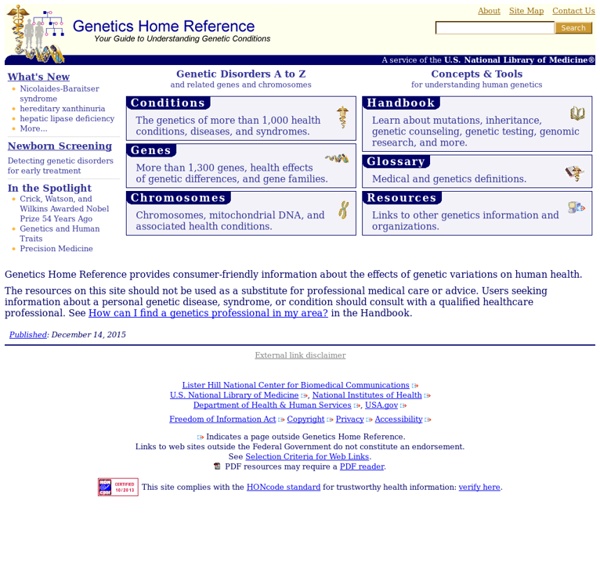



New Genetic Twist: 4-Stranded DNA Lurks in Human Cells Sixty years after scientists described the chemical code of life — an interweaving double helix called DNA — researchers have found four-stranded DNA is also lurking in human cells. The odd structures are called G-quadruplexes because they form in regions of deoxyribonucleic acid (DNA) that are full of guanine, one of the DNA molecule's four building blocks, with the others being adenine, cytosine, thymine. The structure comprises four guanines held together by a type of hydrogen bonding to form a sort of squarelike shape.
s US/Pacific: Sunday, April 20, 2014Sydney, Australia: Monday, April 21, 2014 File Download Time CalculatorInteractive Sign Language & BrailleOnline Eye Test for Computer UsersTest Your Hearing Online World Daily Reports (Weather, Time, etc.)Real-Time Traffic CamsWinlink 2000 - Global Radio Email System All About The Human Genome Project (HGP) All About The Human Genome Project (HGP) The Human Genome Project (HGP) was one of the great feats of exploration in history - an inward voyage of discovery rather than an outward exploration of the planet or the cosmos; an international research effort to sequence and map all of the genes - together known as the genome - of members of our species, Homo sapiens. Completed in April 2003, the HGP gave us the ability, for the first time, to read nature's complete genetic blueprint for building a human being.
3D Animations - Chromosome 11 Flyover Home DNA Learning Center Preparing students and families to thrive in the gene age 3-D Animation Library Chromosome 11 Flyover Cracking the Code of Life Cracking the Code of Life PBS Airdate: April 17, 2001 ROBERT KRULWICH: When I look at this—and these are the three billion chemical letters, instructions for a human being—my eyes glaze over. But when scientist Eric Lander looks at this he sees stories. Online Research Tools and Aids Looking for Documents on Archives.gov? View the Constitution, the Declaration of Independence, and the Bill of Rights Online Catalog Search among more than 126,500 digitized historical documents, photographs, and images. Access to Archival Databases (AAD) Search or browse some of NARA's electronic records. Search by person, geographic areas, organizations, or dates.
PeerWise Welcome to PeerWise To log in, select your school / institution from the list below Sorry, I don't know about that place. Please type a few characters in the box below and then select your institution from the list. Just type the first few characters... PeerWise supports students in the creation, sharing, evaluation and discussion of assessment questions. Chromosome Abnormalities Fact Sheet Chromosome Abnormalities What are chromosomes? Chromosomes are the structures that hold genes. Genes are the individual instructions that tell our bodies how to develop and function; they govern physical and medical characteristics, such as hair color, blood type and susceptibility to disease. The Fruit Fly and Genetics Personals: ♀ FF, Se/E/Dp, seeks ♂ FF, +/+/+ for short term relationship. Enjoys romance, fermentation, and long walks on the peach... You know those annoying little bugs that like to get in your fruit if you leave it on the counter? Well they're called Drosophila melanogaster (or just fruit flies) and they've been used to study genetics for over 100 years. This interactive website is designed to introduce biology students to research on model organisms while reviewing genetics basics. Learning about Genetics Using Flies
Power Search Tool ClickBank is the retailer of products on this site. CLICKBANK® is a registered trademark of Click Sales, Inc., a Delaware corporation located at 917 S. Lusk Street, Suite 200, Boise Idaho, 83706, USA and used by permission. ClickBank's role as retailer does not constitute an endorsement, approval or review of these products or any claim, statement or opinion used in promotion of these products. “Why Do We Have to Learn This Stuff?”—A New Genetics for 21st Century Students Citation: Redfield RJ (2012) “Why Do We Have to Learn This Stuff?”—A New Genetics for 21st Century Students. PLoS Biol 10(7): e1001356. doi:10.1371/journal.pbio.1001356 Series Editor: Cheryl A. Kerfeld, University of California Berkeley/Joint Genome Institute, United States of America
How to work with Drosophila The Natural Science for Teachers Program (formerly General Biology Program for Teachers) offers graduate-level online courses and enrichment opportunities for teachers. The program was designed to address the needs of middle and high school science teachers for graduate-level courses that meet many school districts’ requirements for salary increment credit. Currently we offer 2 educational tracks: Biology and Chemistry. com 9 Last-Minute Tips to Streamline Your Taxes By Andrew Schrage Financial Planning Expert